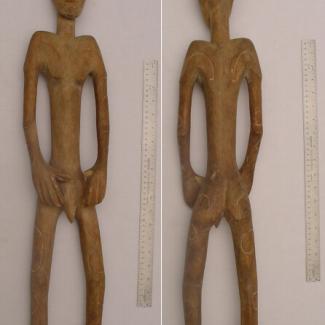This is a wooden Asmat ancestral carving which originally formed a part of a bis pole. The majority of the piece is unpainted, with remnants of white and red paint around the accented physical features. The depiction is of a single human figure of ambiguous sexual identification. It features the characteristic breast carvings of female designs, but also features a distinctly phallic carving at the waist. The figure is in a standing position with legs spread apart and feet facing forwards. The arms are relaxed with hands in front of the hips. The right hand is attached to the waist by the thumb and index finger, but the left hand is not. The face of the individual is very stoic. It features a jutting nose with a pierced nostril, closed mouth, sunken eyes, and subtle brow. The hair is jutting above the head and the ears are very detailed. The curved lines found on the body and limbs suggest stylized muscle definition as found in many Asmat carvings. The pinky toe on the figure’s right foot is missing.
This was likely once part of a larger bis pole used for funerary services for deceased members of Asmat communities. It would stand either on the shoulders of another carved figure or implanted in the ground, with other decorative features supported with it. Poles of this kind were erected for various purposes. The most prominent would be to serve as calmers of deceased spirits while revenge was undertaken on their behalf. Death in Asmat society was never natural; it was always believed to be the work of enemy headhunting or sorcery. In order to restore the spiritual imbalance created by death, headhunting raids would be undertaken as vengeance. Until the raid was complete and balance restored, bis poles would stand outside the home of the deceased to calm the spirits. Once its function was fulfilled, the carvings would be discarded in the rainforest so that their spirits would rejuvenate the sago trees. Bis poles were always carved in the image of ancestors of the carver or of the deceased individual, as part of larger ancestor reverence in Asmat culture.
Colors: Brown, Black

